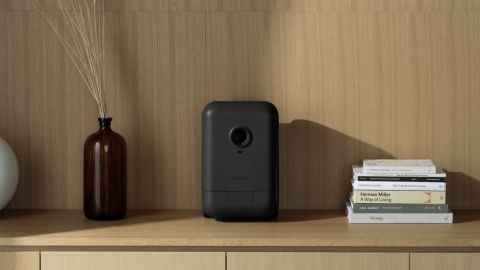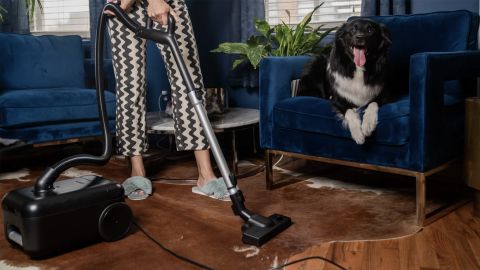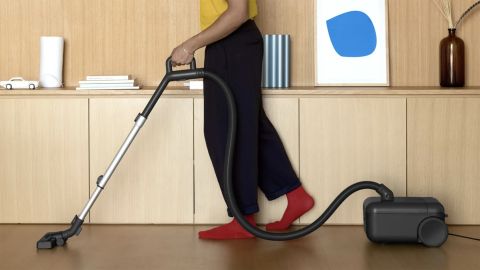I’m a person with a vacuuming philosophy: the best vacuum cleaner is the one you’ll use.
There are many other criteria, of course, for determining the merits of one vacuum cleaner over another – suction, power, versatility, price – but the world’s most inflated and affordable vacuum cleaner is useless if you don’t don’t, well, use it.
When asked to review the Airsign canister vacuum, I immediately said yes. The timing was perfect: my trusty Dyson stick vacuum was losing its juice, so it was time to consider plans to replace it. And, while writing articles about cleaning hard-to-reach places and unexpected uses for vacuums, I found myself wanting more than what a stick model, however beloved, can offer me.
The Airsign has a lot going for it, and it’s a good vacuum cleaner. It’s a particularly good vacuum for its $275 price tag.
The Airsign features a 1200 watt motor and HEPA-14 carbon filter and comes complete with a multi-surface floor head, telescoping wand, brush and crevice tool. Sustainability is a selling point: it touts not just biodegradable bags, but a carbon filter that’s “almost entirely paper-based” and 20% recycled plastic content.
At first glance, the Airsign is massively attractive. Its design is destined to be a big part of its appeal – ads position the Airsign as the canister vacuum for all of Brooklyn – and it’s no coincidence that the vacuum, which measures 15.5 inches on 10 inches by 8.5 inches, could easily be mistaken for your luggage Away in a dark closet.
In addition to its sleek matte black design, it was so simple and intuitive to set up that it didn’t require instructions (instructions are included). It’s also incredibly light at just 10.8 pounds.

Don’t let its sleek silhouette and good looks fool you – the Airsign packs a punch. Even on its lowest setting, for floor and carpet, the Airsign had plenty of suction power. My suction needs are pretty simple: dirt and grime from New York, crumbs and grains of rice, my long Rapunzel hair. The Airsign handled them with ease, although the rotating brush looked like it was wearing a wig after three weeks of picking up the hair. In the bathroom, it sucked up pieces of loose grout and an entire tile. My hardwood floor practically shone after vacuuming.
It was also, thanks in large part to its design, easy to use. The slim vacuum head makes it easy to get under cabinet lips and into thin spaces under furniture. Switching between attachments was simple, and the attachment holder that attaches to the vacuum’s handle is a clever design feature. The on-off switch and cord retraction levers can be operated with a firm step of the foot.
When it comes to deep cleaning, however, the Airsign was just fine. As I used the machine to dust furniture, electronics, baseboards, light fixtures and radiators, I found that I wanted more attachments, especially attachments that didn’t require the wand, which is rigid and inflexible, and which could connect directly to the flexible pipe. . The upholstery brush was a winner for its stated purpose, but when it came to using it as a dusting attachment on hard furniture and electronics, it was awkward and awful. The crevice tool was anything but useless.
With continued use, other problems appeared. A strong smell of “new emptiness” lingered. The lever to switch between mat and floor settings requires extreme pressure to operate, and the plastic feels like it will break under the force needed to switch from one setting to the other. The handle is misplaced. The hose and wand were everywhere, slamming loudly on the floor, hitting me on the back as I bent down to pull the cord from the base. The matte black exterior quickly became mottled with fingerprints.
The Airsign occupies an unusual place in the market in that, technically speaking, its closest competitor is the Miele canister vacuum cleaner. (Miele is generally considered the category leader among canister vacuums and is our pick for the best canister vacuum of 2022.) However, the Airsign is clearly positioning itself as a competitor to Dyson’s stick vacuums, which Domino Magazine calls “the current millennial favourite” in its review of the Airsign and to which the Airsign site itself provides a comparison. In other words, Airsign seeks to take the place of Dyson as a brand of cool vacuum cleaners.
When I tried the brand’s new bagless Miele Boost CX1 and classic Compact C1 Pure Suction PowerLine to get an idea of how they compare to the Airsign, I was immediately reminded why I hadn’t Haven’t used a Miele, or any other canister vacuum, in many years: Canister vacuums are generally unwieldy and inconvenient to use, especially if you’re a fan of stick vacuums. Specifically, I hate what I consider to be the “stubborn dog walking” effect of dragging a piece of plastic on a leash behind you while you clean.

However, a reviewer’s dislike of the canister vacuum doesn’t mean the whole category is without merit. Canister vacuums offer a combination of versatility, maneuverability, and power that cordless and corded upright vacuums can’t. These are particularly good machines for larger homes due to their power, as well as for above-floor cleaning jobs.
After using the Mieles, I felt more optimistic about the Airsign – not only was the Airsign’s performance better in my opinion, but its weight and design had greatly reduced the “stubborn dog walking” effect that I suffer from other canister vacuum cleaners.
However, as the Airsign sat in my house, I came to resent it, and that’s where the natural comparison to the Dyson has to be made. When the rug under my kitchen table needed a look, I realized I didn’t want to use the vacuum that required me to pick it up, pull out the cord, plug it in, struggle with a tube, to unplug it, to retract it. the cord, struggle again with the tube, etc. When my weekly chore day arrived, I didn’t like the extra setup work the Airsign was putting on me; I also hated the space it took up. Basically, I wanted my Dyson.

If you are specifically looking for a canister vacuum, the Airsign is indeed a very good option. Its weight, as well as the way the weight is distributed, solves one of the format’s major problems. For those looking for the power of a corded vacuum, the Airsign also offers: In informal tests, its suction performed incredibly well on hardwood, tile and low-pile carpeting.
However, for quick cleaning in a small space, the Airsign was a chore to use. Its footprint and size still had many of the problems that other canister vacuums have. Turns out the load relief of typical canister vacuums wasn’t enough to make this vacuum a game changer for the Dyson-loving set.
Despite all the Airsign’s good qualities, and there are indeed some very good ones, I was glad to see this vacuum go. After three weeks of use, it was clear that this was not a vacuum cleaner I wanted to use. And so, as an emptiness, it is of no use to me.
